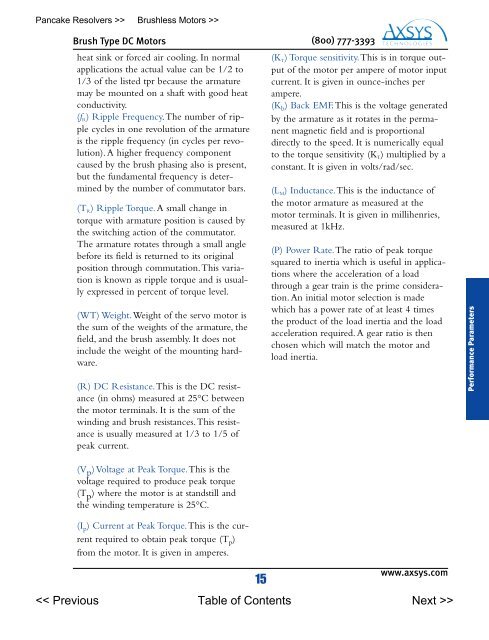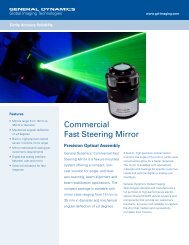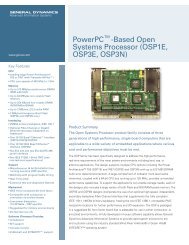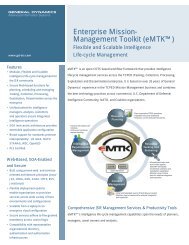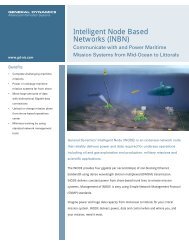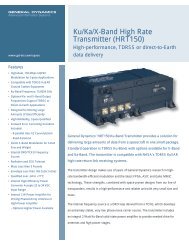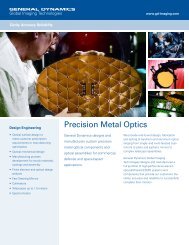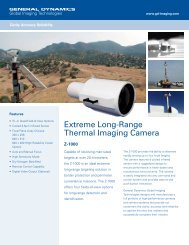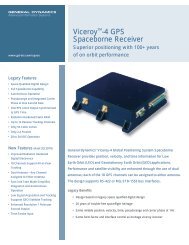Brush Type Manual - General Dynamics Global Imaging Technologies
Brush Type Manual - General Dynamics Global Imaging Technologies
Brush Type Manual - General Dynamics Global Imaging Technologies
You also want an ePaper? Increase the reach of your titles
YUMPU automatically turns print PDFs into web optimized ePapers that Google loves.
Pancake Resolvers >> <strong>Brush</strong>less Motors >><br />
<strong>Brush</strong> <strong>Type</strong> DC Motors<br />
heat sink or forced air cooling. In normal<br />
applications the actual value can be 1/2 to<br />
1/3 of the listed tpr because the armature<br />
may be mounted on a shaft with good heat<br />
conductivity.<br />
(f R ) Ripple Frequency.The number of ripple<br />
cycles in one revolution of the armature<br />
is the ripple frequency (in cycles per revolution).<br />
A higher frequency component<br />
caused by the brush phasing also is present,<br />
but the fundamental frequency is determined<br />
by the number of commutator bars.<br />
(T R ) Ripple Torque.A small change in<br />
torque with armature position is caused by<br />
the switching action of the commutator.<br />
The armature rotates through a small angle<br />
before its field is returned to its original<br />
position through commutation.This variation<br />
is known as ripple torque and is usually<br />
expressed in percent of torque level.<br />
(WT) Weight.Weight of the servo motor is<br />
the sum of the weights of the armature, the<br />
field, and the brush assembly. It does not<br />
include the weight of the mounting hardware.<br />
(R) DC Resistance.This is the DC resistance<br />
(in ohms) measured at 25°C between<br />
the motor terminals. It is the sum of the<br />
winding and brush resistances.This resistance<br />
is usually measured at 1/3 to 1/5 of<br />
peak current.<br />
(V p ) Voltage at Peak Torque.This is the<br />
voltage required to produce peak torque<br />
(T p ) where the motor is at standstill and<br />
the winding temperature is 25°C.<br />
(I p ) Current at Peak Torque.This is the current<br />
required to obtain peak torque (T p )<br />
from the motor. It is given in amperes.<br />
(800) 777-3393<br />
(K T ) Torque sensitivity.This is in torque output<br />
of the motor per ampere of motor input<br />
current. It is given in ounce-inches per<br />
ampere.<br />
(K b ) Back EMF.This is the voltage generated<br />
by the armature as it rotates in the permanent<br />
magnetic field and is proportional<br />
directly to the speed. It is numerically equal<br />
to the torque sensitivity (K T ) multiplied by a<br />
constant. It is given in volts/rad/sec.<br />
(L M ) Inductance.This is the inductance of<br />
the motor armature as measured at the<br />
motor terminals. It is given in millihenries,<br />
measured at 1kHz.<br />
(P) Power Rate.The ratio of peak torque<br />
squared to inertia which is useful in applications<br />
where the acceleration of a load<br />
through a gear train is the prime consideration.<br />
An initial motor selection is made<br />
which has a power rate of at least 4 times<br />
the product of the load inertia and the load<br />
acceleration required. A gear ratio is then<br />
chosen which will match the motor and<br />
load inertia.<br />
Performance Parameters<br />
15<br />
www.axsys.com<br />
>


